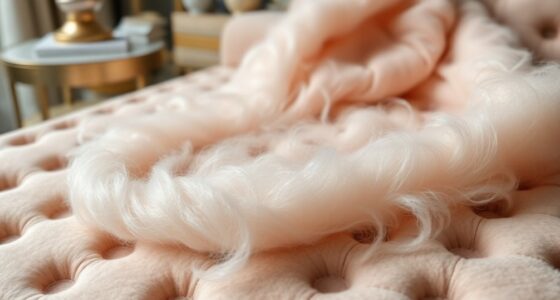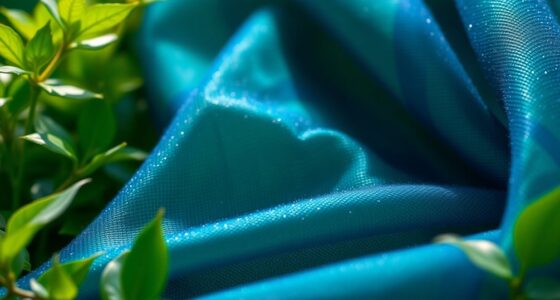Ramie, a fiber with a 6,000-year history, is making a strong comeback thanks to its eco-friendly qualities. Its durability, luster, and resistance to pests have made it popular for centuries in Asia, and now modern designers are rediscovering its potential for sustainable fashion. Because it requires minimal chemicals and grows quickly on marginal lands, ramie offers both tradition and environmental benefits. Keep exploring to learn more about this timeless fiber and its exciting future.
Key Takeaways
- Ramie is one of the world’s oldest fiber crops, dating back over 6,000 years, with historical use in Asia for textiles and currency.
- Its cultural significance is deeply rooted in East Asian traditions, featuring centuries-old processing techniques that are now being modernized.
- As an eco-friendly, biodegradable fiber, ramie requires minimal chemicals, thrives on marginal lands, and promotes sustainable cultivation practices.
- Modern industry trends are reviving ramie’s popularity in sustainable fashion, blending traditional craftsmanship with innovative processing methods.
- Ramie’s timeless durability, luster, and environmental benefits position it as a valuable, eco-conscious alternative in today’s textile market.

Have you ever wondered what makes ramie fiber a popular choice in textiles? The answer lies in its sustainable production and rich historical significance. Ramie, a plant native to East Asia, has been cultivated for thousands of years, making it one of the oldest fiber crops known to humanity. Its long-standing history means it’s deeply woven into cultural traditions, and modern efforts are helping it regain popularity. When you choose ramie, you’re supporting sustainable practices because this fiber is highly eco-friendly. It’s a natural, biodegradable material that requires minimal chemical processing compared to synthetic fibers. Ramie’s cultivation relies on renewable resources; it grows rapidly, requires little fertilizer or pesticides, and can thrive on marginal lands unsuitable for food crops. This makes it a sustainable option for environmentally conscious consumers who want to reduce their ecological footprint. Its ability to be harvested multiple times from the same plant without damaging it adds to its appeal as a sustainable fiber. Additionally, understanding the performance tuning laws and techniques can help manufacturers develop better processing methods that maximize fiber quality and efficiency.
Historically, ramie has been prized for its durability and luster. Records from ancient China, Korea, and Japan show that ramie was used for centuries to produce textiles, paper, and even currency. Its significance extends beyond simple utility; it was often considered a luxurious material reserved for nobility or special occasions. The fiber’s strength and resistance to pests and mold meant it lasted longer than many other natural fibers, making it invaluable in traditional societies. Over the centuries, ramie was traded along the Silk Road, spreading its influence across Asia and beyond. Its historical importance is also reflected in the techniques developed for processing it, which required considerable skill and craftsmanship. Today, these techniques are being revived and refined, blending tradition with modern innovation.
In recent years, there’s been a resurgence of interest in ramie, driven by the global shift toward sustainable fabrics and eco-conscious fashion. Designers and manufacturers are rediscovering its potential, not only because of its environmental benefits but also because of its natural beauty and versatility. Ramie’s tensile strength and lustrous appearance make it suitable for a range of textiles, from fine fabrics to sturdy upholstery. By choosing ramie, you’re part of a movement that values historical legacy and environmental responsibility. It’s a fiber that connects the past with the future—an ancient material making a modern comeback. As more people recognize the importance of sustainable production, ramie’s place in the textile industry continues to grow. This ancient fiber offers a timeless solution that respects both tradition and the planet, making it a smart choice for eco-aware consumers today.
Frequently Asked Questions
Is Ramie Suitable for Outdoor Clothing?
Ramie can be suitable for outdoor clothing if you prioritize sustainable sourcing and textile innovation. Its natural fibers are breathable, durable, and resistant to pests, making it a good choice for outdoor wear. However, you should consider its moisture absorption and potential for shrinkage. By choosing ramie, you support eco-friendly materials and innovative textiles, helping you stay comfortable and environmentally conscious in outdoor environments.
How Does Ramie Compare to Cotton in Durability?
You’ll find that ramie surpasses cotton in fiber strength, making it more durable for long-term use. Its fabric longevity means it resists wear and tear better, especially in outdoor conditions. While cotton is soft and breathable, ramie’s toughness ensures it holds up under frequent washing and exposure. So, if durability matters most, ramie is a stronger choice, offering you a more resilient fabric that lasts longer.
Can Ramie Be Blended With Synthetic Fibers?
Blending ramie with synthetic fibers creates a durable, dynamic fabric that benefits from both natural strength and synthetic stability. You can easily experiment with synthetic blending, enhancing fabric durability while maintaining the eco-friendly appeal of ramie. This combination results in fibers that are not only versatile but also resilient, making your textiles more resistant to wear and tear. So, yes, ramie blends wonderfully with synthetic fibers for improved fabric performance.
What Is the Environmental Impact of Ramie Cultivation?
You might wonder about ramie’s environmental impact, and it’s generally positive. Ramie cultivation supports sustainable farming practices because it requires minimal pesticide use and less water compared to other crops. This means it’s eco-friendly and helps reduce chemical runoff. By choosing ramie, you promote environmentally conscious agriculture, which benefits ecosystems and conserves resources, making it a sustainable fiber option for eco-aware consumers.
Are There Specific Care Instructions for Ramie Textiles?
They say, “a stitch in time saves nine.” For ramie textiles, you should follow specific care instructions. When fabric dyeing, use gentle, natural dyes to preserve color. For laundry tips, wash in cold water, avoid harsh chemicals, and air dry to maintain its strength and shine. Iron on low heat if needed, but always test a small area first. Proper care keeps your ramie fabric looking beautiful longer.
Conclusion
Now that you know about ramie’s rich history and eco-friendly qualities, won’t you consider giving this ancient fiber a modern chance? Its durability, breathability, and sustainability make it a smart choice for your wardrobe. As more people seek greener options, isn’t it time you embraced a fabric that’s been thriving for thousands of years? By choosing ramie, you’re not just wearing a piece of history—you’re joining a movement toward a more sustainable future.









